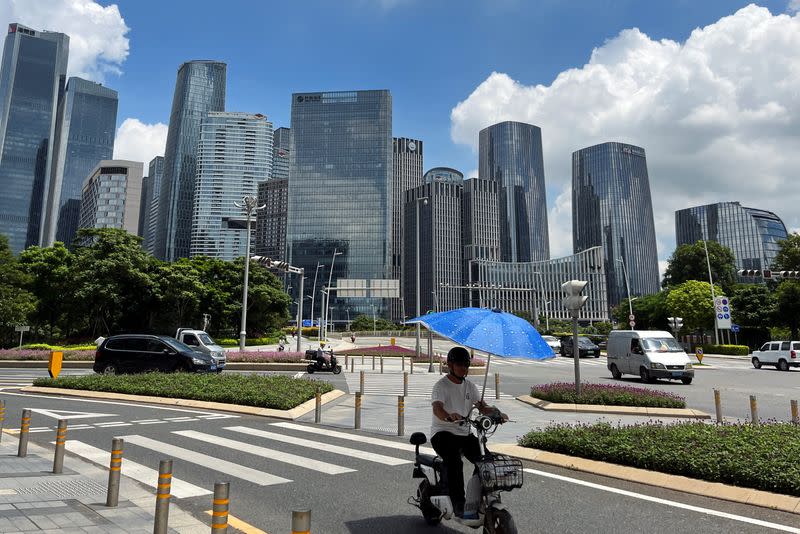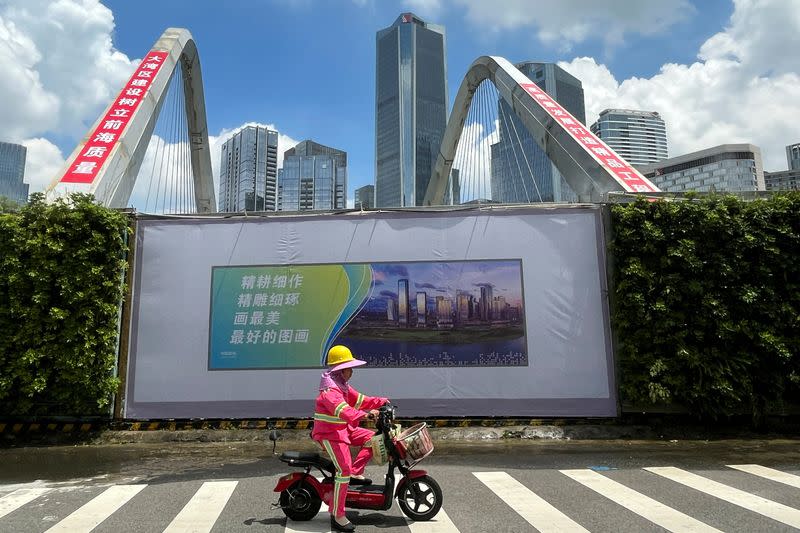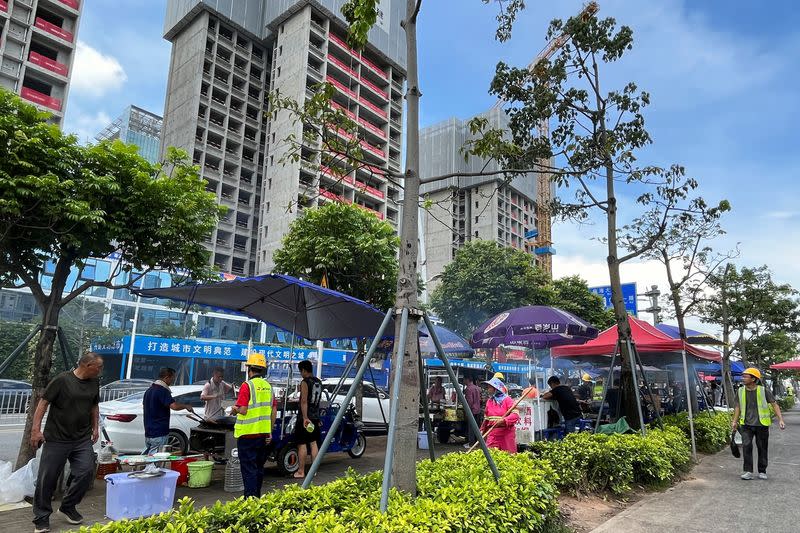China's not-so-special economic zone embodies a harsh new reality
By David Kirton
SHENZHEN, China (Reuters) -Tony Xiong is among the latest arrivals to the glitzy office towers in the newest part of Shenzhen, built to showcase China's economic miracle. He won't spend any personal time in the area.
Most lunch breaks, he drives 20 to 30 minutes to more-established parts of Shenzhen to slurp beef noodles in family-owned restaurants before racing back to work.
"In Qianhai, it's either a 10-minute walk in the sun to the mall or the terrible cafeteria food," said the 30-year-old, a finance worker in a state-owned property firm. "I don't like being there."
Office workers are not the only ones grumbling about the unattractiveness of Qianhai, a special economic zone where Chinese dreams of global financial might and economic prosperity that once seemed inevitable are now darkened by half-empty skyscrapers and shopping malls as well as barely used motorways.
This Shenzhen appendix opened for business more than a decade ago after an initial investment of $45 billion, with state media calling it mainland China's own Hong Kong: a future international tech and finance hub; a testbed for liberalising markets and information access.
But Reuters interviews with 10 executives and investors, as well as real estate experts, diplomats and economists and 10 workers in the area during six visits between September and November paint a picture of a largely deserted district that has given up on its reformist ambitions. At the same time, these people said, Qianhai is struggling to stand out among 2,500 other special zones across China dangling various subsidies at reluctant businesses.
Five economists and three diplomats told Reuters Qianhai's travails reflect the limits of China's old "build it and they will come" growth model - one that worked wonders a generation earlier for wider Shenzhen, among the country's first and most successful special economic zones.
The office vacancy rate was 28.9% in the third quarter, near the highest in three years, versus 23.2% in Shenzhen overall, and 15.1% to 17.1% in Beijing and Shanghai, according to Knight Frank, despite Qianhai's lower rental prices.
And that's before China's tallest skyscraper of over 1,000 metres and a cluster of other towers are completed. The relentless supply has driven up vacancies, but newcomers other than state-connected firms are hard to find, three real estate executives told Reuters on the condition of anonymity due to the subject's sensitivity.
With China entering a new era of sluggish growth, Qianhai may never reach the international status to which it aspires.
Analysts say Qianhai, and China, need to resume the market overhauls Beijing intended to pilot in the special area more than a decade ago, while the economy as a whole needs to rely more on household consumption for high growth to resume.
"When a country reaches the state of development of China today, one cannot grow from special zones," said Antonio Fatas, a professor of economics at INSEAD international business school. "Growth is much more complex, it requires reforms that are comprehensive."
The Qianhai Authority and China's State Council Information Office did not respond to Reuters requests for comment on the local and macro economic challenges.
UNFULFILLED PROMISES
In the past four decades, Shenzhen grew from a collection of villages into a megacity of 18 million people, home to some of China's biggest firms.
It became the runaway success story of former Chinese leader Deng Xiaoping's "reform and opening up" policies, with its business friendliness since replicated by other cities, especially along the Pearl River Delta, in tandem with an unparalleled infrastructure build-up.
In 2010, Beijing approved the Qianhai project as a policy laboratory to jumpstart a new growth stage for China.
Plans included a Hong Kong-like independent antigraft body, a pilot to pioneer the gradual opening of the country's capital account and internationalising the yuan; and full internet freedom throughout the area.
When President Xi Jinping visited Qianhai on his first trip as general secretary of the Communist Party in 2012, predicting it would be "more special than a special zone," those changes seemed just the beginning of a more open China.
But the plans were scrapped one by one over the following years.
By the time Xi returned for the 40th anniversary of Deng's changes in 2019, the mood had soured, as state supervision over markets tightened, the capital account was largely sealed after an outflows scare in 2015, and censorship and surveillance intensified.
"The last 10 years have not been about real reforms and open doors," said Zhiwu Chen, professor of finance at the University of Hong Kong. "Instead, reversals of past reforms have carried the day," he said, adding this has stifled Qianhai's progress.
"In the old days, officials in Qianhai would have been encouraged and incentivised to experiment with creative policy innovations. In the current political environment, officials put much higher priority on minimising risk."
LOW TAXES, SUBSIDIES
Without the promised changes, Qianhai's remaining selling points are income taxes of 15%, versus 25% in most of China, its proximity to Hong Kong, and some of the country's newest office and commercial facilities, which come with a one-off 30 million yuan ($4.1 million) subsidy for purchases and up to 5 million yuan yearly for rents.
Qianhai Authority, which runs the area, says more than 100,000 companies have set up shop in the area, including HSBC, UBS and Standard Chartered.
The zone has attracted family offices, venture capital and private equity funds, said Witman Hung, delegate to China's parliament and formerly the authority's principal liaison officer for Hong Kong.
But property agents, executives and investors say many firms that registered in Qianhai never physically moved there.
"We don't actually have any people there, I've never even gone to the address," said Brian Miller, who owns a warehouse business elsewhere in Shenzhen but registered in Qianhai on his accountant's advice.
A tech executive who spoke on the condition of anonymity because of the topic's sensitivity said his firm rents in Qianhai for tax reasons and to maintain good government relations. He had planned to expand operations there but changed his mind as the economy slowed. He now keeps a skeleton crew.
"It's not a Qianhai problem, it's a macroeconomic problem," he said.
ZONED OUT
Another drawback is that Qianhai's incentives are similar to what other special zones offer, including those nearby such as Nansha near Guangzhou and Hengqin next to Macau. But Qianhai rents are double those in Hengqin and sixfold those in Nansha, agents say.
"Before, every area had a little speciality to follow but now anywhere can do everything, it's too confusing," said Klaus Zenkel, who chairs the European Chamber of Commerce in South China, adding no new European companies were moving in.
"The infrastructure is there, it's just - how do you convince companies to come?"
A chamber survey of 75 companies in June found only 44% were optimistic about the Greater Bay Area, another name for the cluster of southern Chinese cities, down from 68% in 2022.
Bill Deng, CEO of cross-border finance firm XTransfer, says he won't move to Qianhai.
Hong Kong "has a global system that's free, they have the talent, they have the experience," he said, adding the mainland has been "very cautious" about financial opening.
On Qianhai's streets, some people are enjoying the serenity. A driving instructor finds the area perfect for first lessons. A shop assistant levels up on a smartphone game.
At a cafe close to a rock inscribed with Deng's calligraphy of Qianhai, a barista who only gave his surname, Zhang, spends most of his time chatting with other staff.
"There aren't many customers and I don't think lots of people visit for the rock. Sometimes I'm bored, but quiet is good," he said.
($1 = 7.2780 Chinese yuan renminbi)
(Additional reporting by James Pomfret; Editing by Marius Zaharia and David Crawshaw)



